Preparing for a trip…
Fact: I don’t get out to shoot as often as I would like. I enjoy the outdoors, and get out to hike as often as I can, but there are many other important aspects of my life that limit my time in the woods. However, that makes the time that I get out to shoot more valuable, and therefore I try to make it as enjoyable and productive as possible. Because of this, the planning of photoshoots becomes incredibly valuable.
Before my trip to Mount Pierce, I had to decide that Mount Pierce was the best shot for this weekend, and that I was able to make the shot happen.
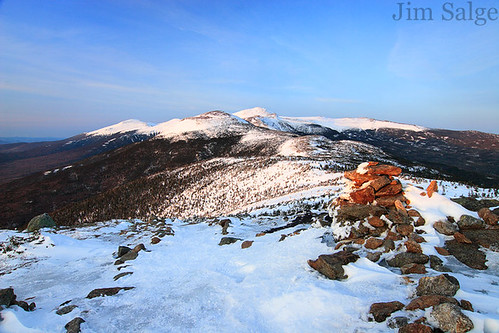
The first and most important aspect to planning a phototrip is the weather. Days in advance, the weather for the weekend looked clear and cold. However, there would be limited snow in the valleys, and therefore I had the mindset for a certain type of shot. It’s important to know what type of weather would be conducive to the shots on your ‘want list’ so that when it arrives, you can act on it appropriately.
With the forecast pointing to a shot from the alpine zone, my next goal is twofold. Most important is to find someone to go with. I don’t always hike with others, but sunsets in the alpine zone dictate a buddy system. I fortunately have a pretty good network of people who with a few days notice are usually up for a hike at odd hours. This week, I was lucky enough to hike with Will Tourtellot, a former AMC Naturalist and MWO Intern. And a fine photographer.
Lastly, the planning goes to picking the right peak for the anticipated light and time of year. Mount Pierce has a classic view of the Northern Presidentials, but the light in the dead of winter comes from behind you.

In late March, the sun’s northward journey lights up the peaks much better. To help visualize the shots, I use a combination of Google Earth and a great program I’ve found called the Photographer’s Ephemeris. This program lets you plug in the date and location, and it shows you the path of incidence of sunlight at sunset. Very useful, as you can see from the screenshot!
Beyond that…gear up and go! As often as possible. Which I will have to do for the dream shot of Mount Pierce that still eludes me, as I discussed in the last post!
Mount Pierce Adventure…
I have a running checklist in my mind of shots in the mountains that I ‘need’ to get. The problem is that the weather in the mountains is so fickle, that even when I visit the locations, it’s rare that I get the shot I’m after. That’s one of the reasons that I began this blog, so that I can share pictures and stories that would otherwise not make it into my porfoilio, and to share the joys, struggles and techniques I use when out shooting in both ideal, and less than ideal conditions.
Yesterday’s hike to Mount Pierce was definitely much more about the hike and the experience of the outdoors, and the subtle beauty and feeling of winter (yes, still very much winter) than the photographs.
It’s amazing how much the recent storms have impacted the forest. The hike up, which is normally one of the easiest hikes to a 4000 foot peak in NH, was slowed a bit by trees that had blown across the trail, and snow so deep that we were hiking with our heads above the cleared trail ‘tunnel’. On top of that, the broken out trail turned away from the actual trail in a straight line to the summit. This lead to a few falls into ’spruce traps’ or hollow snow bridges supported by buried spruce trees. Evacuation from these holes is a challenge.
The view from Pierce is a White Mountains classic.

The View From Pierce
The first sight of the view to the north when emerging from the trees truly takes your breath away. And there was little else to take your breath yesterday, as wind was calm, allowing us to hang at the summit itself for a couple of hours.
The light on the mountains that I have seen in my dreams never came, but the sunset itself was beautiful.
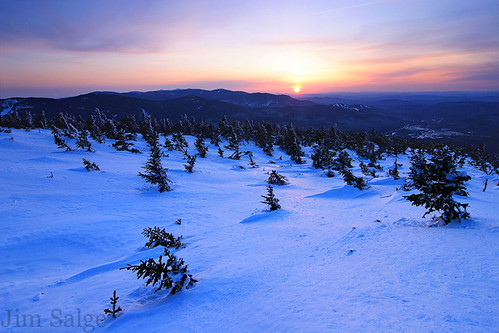
Sunset From Pierce
The hike out under headlamp was easy after the first mile or so of re-raking our faces in the trees. The moon was up, and dappling the snow on the forest floor with intense blue light. I certainly will not complain about ‘having to come back’ to get my dream shot!
I’ll share more shots, and some details on the planning of this trip later in the week…
Macro Practice…
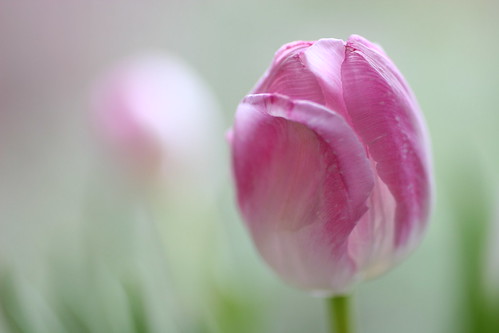
Canon 50mm Macro; 1/20s @ f2.5

Canon 50mm Macro; 0.5s @ f8.0
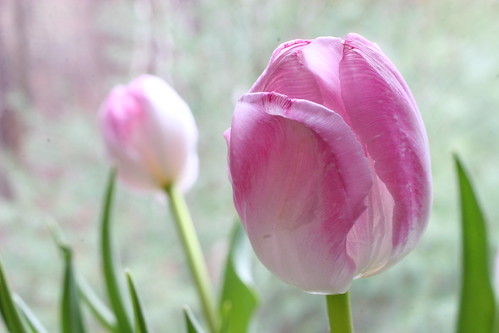
Canon 50mm Macro; 1.6s @ F16
Now I shot the same series with my 150mm lens. This time I had a working distance of 23 inches to get the same magnification, which gives you a lot more room. Also notice that in the depth of field series, the overall depth of field is shallower. This allows you to isolate subjects more in the field, while the 50mm would be better if you wanted to show more of the environment immediately surrounding the subject.

Sigma 150mm Macro; 1/25s @ f2.8
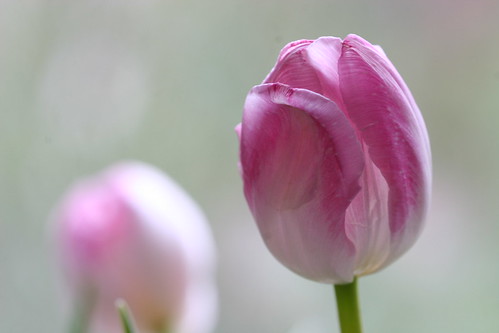
Sigma 150mm Macro; 0.3s @ f8.0
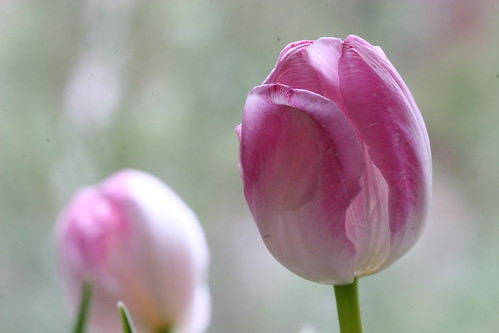
Sigma 150mm Macro; 1.6s @ F16
Another interesting thing to practice with is maximum magnification of a lens. There reaches a point where the subject becomes to close for the lens to focus upon. When you move this close, the depth of field becomes extremely small. Here’s two maximum magnification shots with the 50mm with a working distance of about 2 inches.

Canon 50mm Macro; f2.5 at Maximum
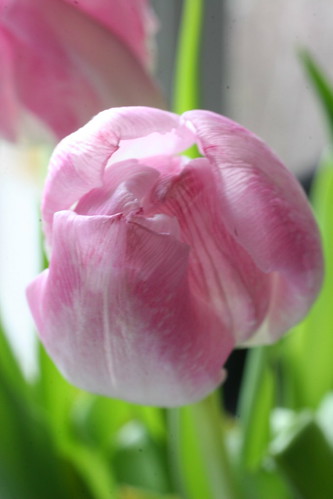
Canon 50mm Macro; f16 at Maximum
And here’s two maximum magnification shots of the 150mm, with a working distance of about 7 inches.
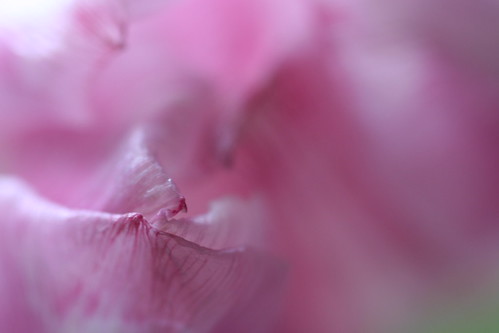
Sigma 150mm Macro; f2.5 at Maximum
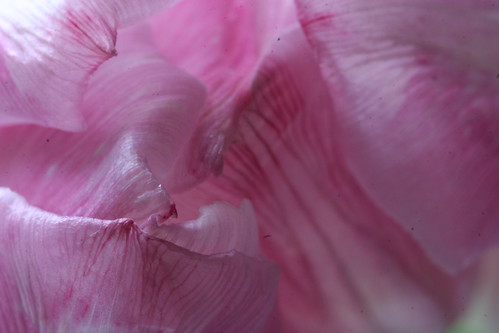
Sigma 150mm Macro; f16 @ Maximum
You will notice that the 150mm appears much bigger in the frame, which is a function of the fact that it offers 1:1 magnification. What that means is that the subject is projected upon the sensor through the lens at the same size as it is in real life. Then when you blow it up…you get apparant magnification!
The last series that I shot was adjusting my lenses to shoot beyond maximum magnification. To do so, you have to attach extension tubes, which allow for closer focusing, less working distance, and amazingly, the exact same depth of field. When you add a 12mm extension tube, it makes a significant difference to a 50mm lens, but not much to a 150mm lens.
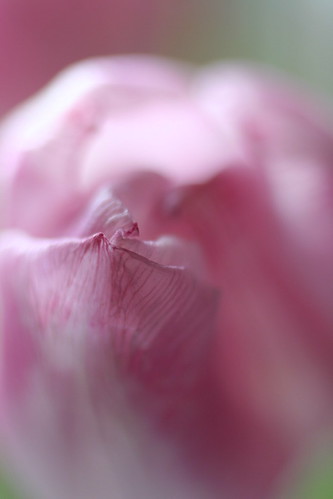
Canon 50mm w/12mm Extension; f2.5 Beyond Maximum

Sigma 150mm w/12mm Extension; f2.8 Beyond Maximum
A couple of last notes. First off, these shots would not be possible without a tripod. When you are dealing with compositions so slight, and exposures so long, you need a rock of a tripod to rest your camera upon. Any movement that you make with a macro lens is dramatically magnified, so handholding is usually out of the question.
Additionally, focusing manually is also important, as the lens auto focus has little idea what do do with a macro composition. Select the object most important to your composition, keep it sharp, and let the rest fall into an artistic blur that you control with your depth of field through the aperture setting.
Finally, it is great fun to work through the exercize of getting to know your lens, and I hope you found this helpful. Besides the benefits of practicing, I learned something else today…my sensor is REALLY dirty. Gotta do something about that before the hepatica emerge in the next two weeks!
Backing up and looking forward…
Mud season is a tough time for the nature photographer. Conditions are varied, ever changing, and rarely ‘classically beautiful.’ Throw in the heavy rain and flooding of the past week, and well, I don’t have much new to share.
These down times are a good time to work on both the past and the future in the photography world. The past…I’m notoriously bad at backing up my work. I just am. I always drop my best RAW files from a shoot onto an off site server, but the majority of my images sit on two parallel hard drives in my computer, and never often enough I back up onto an off site external. There’s really no excuse for this…and for $59 dollars from newegg, I just got an new external hard drive large enough for my entire collection in case of catastrophe. As part of your spring cleaning regime…I might recommend y’all doing so as well.
As for looking forward…spring arrivals and spring weather has gotten me back into refreshing myself on the ecology and chronology of spring. I’m spending time brushing up on birdsong, pouring through wildflower books, and seeking out new locations to shoot. It’s nice to hear and see some old standbye’s and harbingers too. And though I’m not a bird photographer, it’s still nice heard the familiar calls of the woodcock, the winter wren, and the fox sparrow…and early migratory bird arrivals for the first time this week. Still no red winged black bird though. For those interested in keeping up with bird arrivals in the area, a nice site to follow is the New Hampshire Birding List.
I’m planning trips to a number of locations this spring that hold potential for spectacular landscape scenes. Waterfalls and mountain tops are my spring standbys, but I’m looking to new locations as well. After really enjoying Ponemah Bog last year, one of the places I’m most excited about is the Saco Heath, a large acidic bog in southern Maine. These environments tend to have a lot of unique plant life, including carnivourous plants. But Rhodora, a small flowering shrub with showy pink blossoms, also grows well in the bogs, and I’m hoping it’ll put on a great show in Mid May.
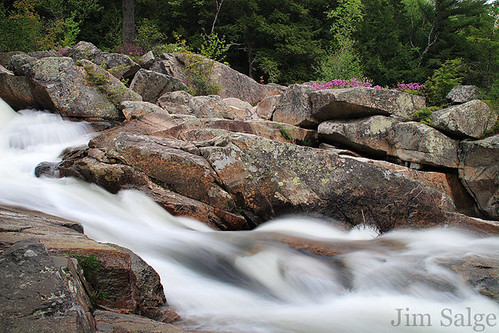
Rhodora at Jackson Falls - Early May 2009
Lastly for this week, with a bit more of mud season to go, I’ll be in research mode for a bit longer. Spring wildflowers then begin in the first weeks of April. In the mean time, I’d love to hear from you as to your favorite places to shoot in spring. If there are any special places in southern and central NH, or southern Maine that I should know about, please let me know…
Sunrise on Wildcat…
There have been two things that I’ve long wanted to do, and have consistently been put on the back seat for one reason or another the past few years. One is catch sunrise from Wildcat as the alpenglow hits the eastern slopes of Mount Washington. The other is to learn to telemark ski, to ease the burden of winter travel.
I’ve always been a snowboarder, but the desire to telemark ski began a few years back on a predawn hike to Tuckerman Ravine with my buddy Greg Petrics of famousinternetskiers.com. Greg moved up the mountain with ease as I labored under the weight of snowshoes on the feat and snowboard and camera gear on my back. I still owe Greg for his help that day. This winter, I finally got the equipment, and went out a few times to try it out…it’s tough! I’m by no means competent, but was confident I could survive down the Polecat this weekend.
My fiance is always nervous about midnight hikes, so we were both relieved that my friend Ryan, the night observer at the Observatory, was on his off week, and up for the hike. We were up at 2:30 and on the trail by 3:30. As this was my first time on skins, it took a bit to get the feel of the motion of it all, but was SO glad to have begun making the switch. During the hike, we watched a quarter moon rise over the Carters, and illuminate the large mountain of pure white snow ‘across the street’. Just beautiful.
The summit and the sunrise arrived at about the same time, and moderate winds, relatively mild conditions made for fairly easy shooting. The alpenglow was intense, but the clouds were lacking to catch the early light. I also struggled for foreground in the compositions, and am pledging to hike the ridge this summer to look for other angles and outlooks.

First Light on the Ridge
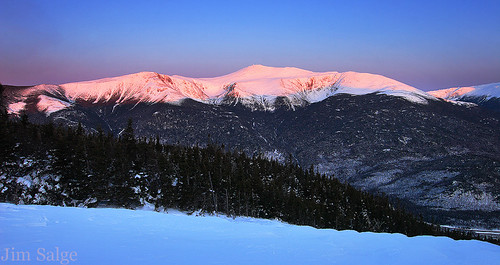
Intense Alpenglow From Wildcat
By 7AM the show was over. I took off the skins and began the trip down. I mentioned that I thought I could survive the trip down. Barely survive I did. With heavy pack and tired legs, it was slow, and tough going. I certainly wouldn’t insult the art and sport of telemarking by claiming that what I did was that. But it was fun.
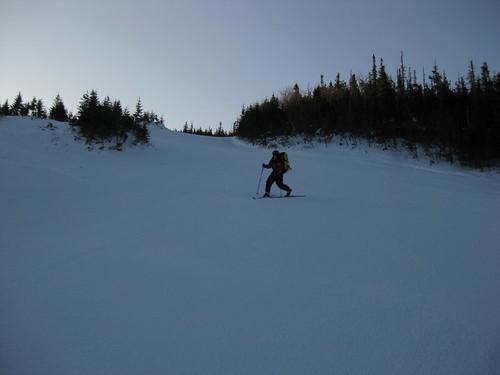
Up - Ryan Knapp Photo
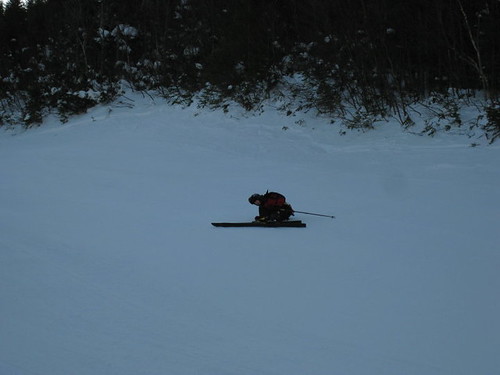
...and Down - Ryan Knapp Photo
An interesting final note…as I reached the bottom, I was greeted by some of my current students, just beginning their day of skiing as the lifts began to turn. Though they are aware of my odd hiking hours, I think that they were a bit confused as I was putting the skis in the car as the lot began to fill. But, I was tired and breakfast at Pinkham was calling. A full day by 8AM!
Spring on my Mind…
Well, it’s good to be back at my computer after a prolonged power outage last week. The remainder of vacation week did not allow me to accomplish many of my shooting goals, as the weather really never cleared. I still hope to make a few trips up north before the snow disappears…as there are some views I need. Look for a sunrise from Wildcat, a sunset from Pierce, and a glorious wide shot from Tuckerman Ravine at somepoint before May if all goes to plan. Heck, after the challenging weather and lack of views during the past week…I’ll take one of those!
I was fortunate to be in a great location on the one clear day last week. I mentioned in brief that I spend the night on Mount Washington last Monday, and have edited down my favorite shot of the week. Stacey Kawecki, an observer at the Mount Washington Observatory can be seen here taking in the magnificent undercast around the Southern Presidentials. Not much to this shot besides right place and right time. I did have a polarizer on…but I believe that’s it. You can view the shot below in a larger format here.
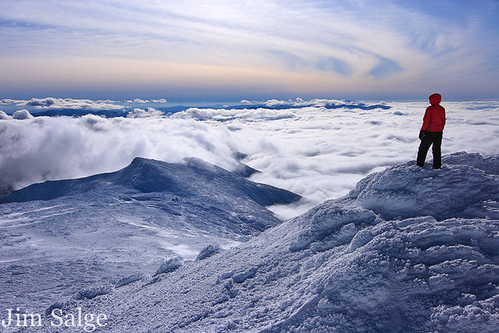
Observing the View ... Undercast on the Southern Presidential Range
For winter shots, time is running out. Signs of seasonal change are all around us already. This morning I drove to work in partial daylight, and the sunrise/sunset will break the 6 o’clock barrier on each end by mid-month. The edges of ponds and lakes are thawing. The forests are awakening from their deep winter state of dead quiet, and birdsong is beginning. The cardinals and finches are becoming vocal…and soon the wrens and red wing blackbirds will start. And though a long way from leaf out…the pussy willows around my neighborhood are beginning to pop! The first wildflowers, the hepatica, the colt’s foot and the skunk cabbage, are about a month away!
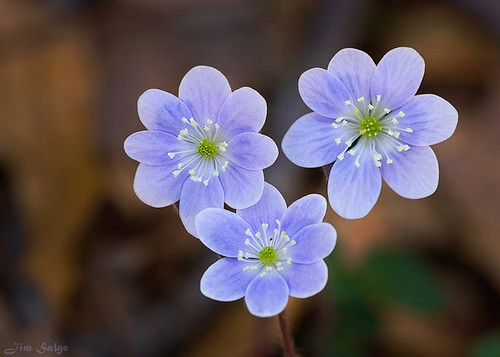
Round Lobed Hepatica - First Wildflowers About a Month Away!
All this certainly doesn’t mean that winter is over, but the seasonal transition is a nice time of year, and spring fever is a good state of mind to be in!
Snapshots of interesting sights…
The pursuit of pictures has become the main activity that I partake in while experience the wilderness, but the enjoyment of the outdoors is always the goal. There is so much to experience, learn about and generally see in the world around us, it’d take many lifetimes before I could experience it all. But I’ll try…
After the great light show at Chocorua Sunday morning, the light changed dramatically, and clouds and snow quickly moved in. My buddy Ed O’Malley, also a photographer, was up visiting the area, and we decided to just tour the Southern Whites, visiting some popular summer spots to see what they looked like in winter. Just for the experience…and maybe some passable shots would come out of it.
I’d like to share some snapshots of those experiences:
First stop was Beede Falls, just north of Squam Lake. I was hoping that there would be water flowing through ice, possibly leading to some photo-ops…but what we found was just amazing. The water was completely encased, but you could get behind the ice in a truly spectacular cave of water in all three states! Great experience #1 of the day…

Front View of Beede Falls

Behind Beede Falls...
From there we went to the Flume Gorge, which if you’ve never been to in the winter, you really owe it to yourself to climb through. Traction recommended…as the whole place, walls, brook and underfoot was one spectacular ice formation. Just an amazing thing to see.

Ed O'Malley in Flume Gorge

Covered Bridge Beyond the Gorge
Continuing on in Franconia Notch, we poked around ‘The Basin’ and found a great world of ice and water. This location yielded what was for me, my favorite shots of the day after sunrise in the brook above the main pothole.
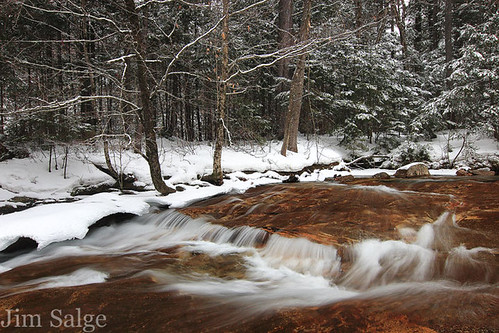
Rapids Above the Basin
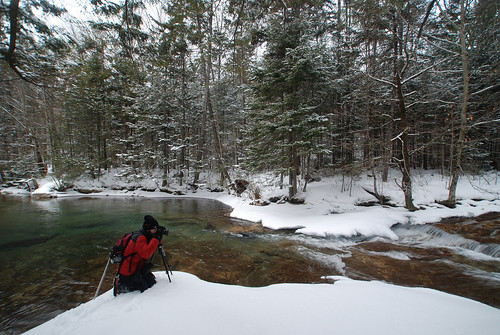
Setting up the Shot
The last location was Beaver Pond in Kinsman Notch. The ice on the pond was wind whipped smooth, and the fresh snowfall was blowing by with impressive ferocity. We probably sat on the ice for about 45 minutes just watching the patterns in the blowing snow. Unfortunately, with all the snow in the air, a lot of snow got trapped between my filters, and became unusable…so I’ll direct you to Ed’s shots for that:
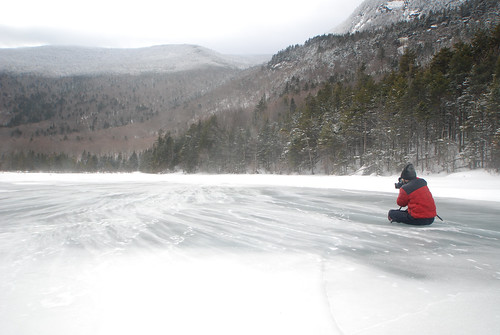
Ed O'Malley's Shot of Me on Beaver Pond
In winter it seems that so many people lock themselves in and wait until spring…but those who do are truly missing out…there are some truly spectacular sights to see in the heart of winter!
Trip Cut Short…
I’ve been looking forward to this vacation week for some time now, and have been planning out lots of shots for my gallery. Among the ideas were a bunch of shots of Mount Washington, including sunrise from Wildcat’s summit, and sunsets from Pierce and Martha. As a photographer though, the one thing you cannot count on though is the weather, and this week proved that. Mount Washington has been in the clouds every day except the one day I was on it, and looks to be socked in through the end of the week. Add to that the rain in the forecast, and well, I’m home early!
Even though I didn’t get to accomplish many of my pre-planned goals, I did have a productive few days of shooting, and look forward to sharing some images, some stories and some knowledge in the coming days. And a good place to start with that is the beginning…
Sunday morning I drove up from my house at 4AM to catch sunrise at Chocorua Lake. The view over the lake to stunning Mount Chocoura is one of the most photographed views in the state, and I’ve tried to get a decent sunrise from this location over a dozen times, with little luck. I’d be lying if I said I wasn’t confident this morning either.
I met my buddy Ed O’Malley (I’ll share some of his shots next post) there a bit before sunrise, just as some GOOD light was hitting the clouds looming over the peak! Luck had finally changed!
Over the next half hour the pinks and oranges of first light moved from the high clouds to the low clouds to the mountains themselves before being pinched off by clouds near the horizon. I focused my efforts on the line of ice and open water near the bridge, which coincidentally seemed to take the shape of the mountain looming above it. Symmetry at its best…
A note on the technicals…all of these were shot with four stops of ND filtration, and a polarizer to cut the light. Many of my exposures that morning ranged from 10 to 20 seconds…which really helps the color saturation pop!
I have a bunch of shots to examine and edit through, but these are early favorites. Would love to hear how they strike you…
Thanks for reading…more to share soon!
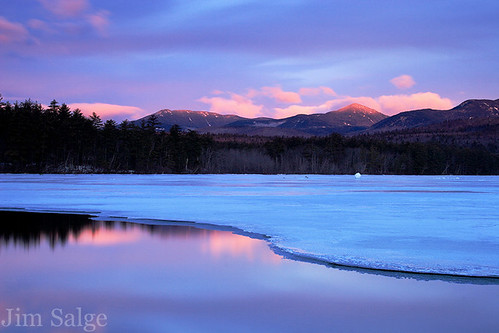
Jim Salge Photography - Chocorua Lake #1
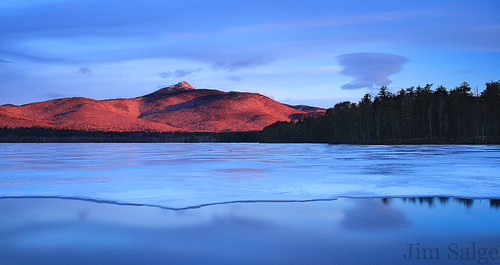
Jim Salge Photography - Chocorua Lake #2
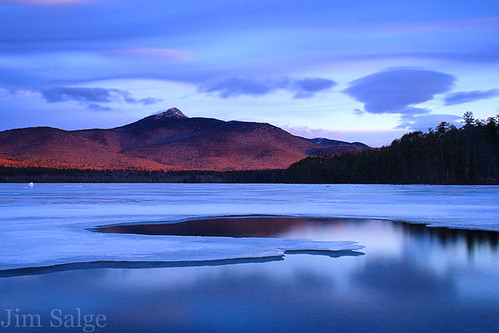
Jim Salge Photography - Chocorua Lake #3


